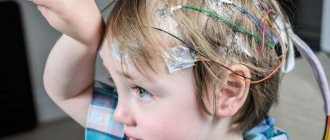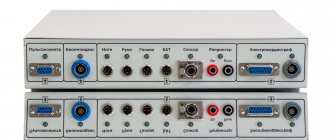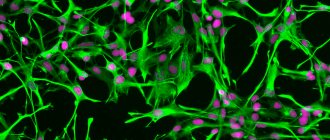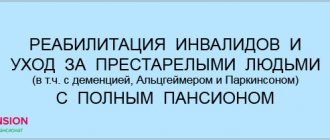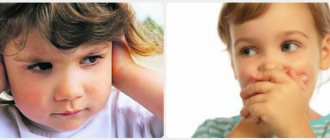Main reasons
The causes of the disease can be:
- Pathology of intrauterine development: maternal illnesses, injuries;
- Genetic predisposition;
- Complications during childbirth: hypoxia, infection;
- Head injuries;
- Poisoning with toxic substances.
Risk factors for the development of motor alalia may be frequent illnesses in children in the first years of life, surgical interventions under general anesthesia, insufficient speech contacts, as well as pedagogical neglect.
Classification of pathology
Doctors have developed several typologies of alalia that characterize the main types and forms of this disease. The most widespread classification involves the presence of expressive, impressive and mixed types of speech underdevelopment in children.
The expressive (motor) form of the pathology develops due to damage to the speech motor analyzer located in the cortical part of the brain. The child understands other people's speech, but is unable to reproduce his own.
The impressive (sensory) type of the disease is caused by damage to the speech-hearing analyzer, located in the cortical part of the brain. The patient retains the ability to perceive sounds, but does not understand the speech of others and is not capable of forming his own speech.
Mixed types of ODD suggest that the child has signs of expressive and expressive disorders.
Symptoms
Motor alalia is characterized by the presence of both non-speech and speech symptoms. Non-speech manifestations of pathology, first of all, include motor disorders such as insufficient coordination of movements, clumsiness, and poor development of motor skills of the fingers.
Motor alalia in a child may also be accompanied by difficulties in developing self-care skills, such as tying shoes or buttoning buttons. Also in performing precise small movements with the hands and fingers: folding puzzles, construction sets and mosaics.
Also, children with motor alalia often have disorders of memory, perception, attention, emotional and volitional spheres of personality. Both hyperactive and hypoactive behavior are observed. There is rapid fatigue and decreased performance. In addition, patients with alalia often experience disturbances in the movements of the facial muscles, increased irritability and aggression, and poor adaptation to the conditions of the surrounding world.
Speech symptoms of motor alalia in patients include:
- erroneous replacement of sounds in words with others;
- loss of sounds from words;
- persistent repetition of a word or phrase;
- limited vocabulary;
- combining syllables of different words;
- replacing words with ones that are similar in meaning or sound;
- loss of prepositions from a phrase, incorrect agreement of words in a phrase.
The vocabulary of a patient with alalia is significantly poorer than the age norm. The patient has difficulty learning new words; the active vocabulary consists largely of words and phrases of everyday use. Insufficient vocabulary can lead to misunderstanding of the meaning of a word and inappropriate use of words.
Patients with alalia, as a rule, express themselves in simple short sentences, which leads to a gross disruption of the formation of coherent speech in the child. Patients have difficulties in determining cause and effect, main and secondary, temporary connections, conveying the meaning of events, and presenting them sequentially.
In some cases, with motor alalia, the child has only onomatopoeia, babbling words, the use of which is accompanied by active facial expressions and gestures.
Signs of motor alalia in children
Symptoms vary in severity: from minor difficulties that practically do not interfere with normal life, to a complete absence of spoken language. Both the phonetic-phonemic and lexical-grammatical components suffer.
At an early age, the pathology is characterized by poor speech reactions. A 2-year-old child may have no babbling at all. Children actively use gestures, onomatopoeia, and primitive babble to communicate.
A child only develops his first words at the age of 3 or a little later. And at the same time he confuses sounds, replaces them, skips them. Can repeat syllables or individual sounds, connect inappropriate syllables from different words.
A 4-year-old child has a poor vocabulary, the phrases are incomprehensible and incorrectly composed. And in the future, he mainly uses nouns, ignores conjunctions, prepositions, and very rarely uses adjectives, verbs, adverbs, and function words. Words do not agree in cases, numbers, genders and tenses. He divides words when speaking and speaks slowly.
A baby cannot repeat sounds after an adult, not to mention phrases. He cannot relate the word and the situation, so he uses words incorrectly.
At the same time, the child understands the addressed speech: he can fulfill the request or respond with a gesture.
Symptoms of psychological and neurological disorders are also observed. Such children, as a rule, are not very active. They are calm about their condition. In general, they are clumsy and have poor coordination and fine motor skills. For example, it is difficult for them to thread a needle, pick up a small object and transfer it.
Attention, memory, and thinking suffer. Children have an unstable emotional background, they are whiny, which makes communication with others even more difficult. There may be sleep and appetite disturbances.
Diagnostics
To diagnose motor alalia, it is necessary to examine the child by a pediatric otolaryngologist, neurologist, speech therapist, or psychologist.
When conducting a speech therapy examination of a child, considerable attention is paid to collecting a perinatal history and the characteristics of the patient’s early development. To diagnose motor alalia, it is necessary to assess the child’s desire to speak, determine the presence of difficulties in repeating what he heard, auditory perception, active use of facial expressions and gestures, perception and understanding of speech, and the presence of echolalia. In addition, the level of active and passive vocabulary, syllabic structure of words, pronunciation of sounds, grammatical structure of speech and phonemic perception are noted.
To assess the severity of brain damage, electroencephalography, echoencephalography, magnetic resonance imaging of the brain, and x-ray examination of the skull may be required. For differential diagnosis with sensory alalia and hearing loss, audiometry, otoscopy and some other methods of studying auditory function are used. Differential diagnosis with dysarthria, autism, mental retardation, and delayed speech development is required.
Prevention
Based on the reasons for the development of alalia, we can name general preventive measures during different periods of pregnancy, fetal and child development:
- Preparing for pregnancy (examination, treatment of chronic diseases, sexually transmitted diseases, taking vitamin and mineral complexes, healthy lifestyle).
- Favorable course of pregnancy, for which it is important to maintain a healthy lifestyle, constant monitoring in the antenatal clinic, following recommendations for taking vitamin complexes for pregnant women and a set of exercises for pregnant women.
- Minimize the possibility of contracting infectious diseases during pregnancy.
- Competent management of childbirth.
- Lactation.
- Avoid injuring the baby (head injury).
- Protecting the child from infections.
- Physical development of the child (swimming from one month of age, gymnastics, massage).
- The intellectual development of a child, which is achieved by playing with him, reading, and constant communication.
- Maintain a favorable psychological environment in the family.
- Start working with a speech therapist in a timely manner at the slightest deviations in speech development.
- Work hard with your child at home to prevent intellectual development delays.
Treatment
Treatment of motor alalia is complex. The formation of speech skills is carried out against the background of drug therapy, the main purpose of which is to stimulate the maturation of brain structures.
Patients are prescribed nootropic drugs and vitamin complexes. Electrophoresis, magnetic therapy, laser therapy, decimeter wave therapy, transcranial electrical stimulation, acupuncture, electropuncture, and hydrotherapy are effective.
An important role in the treatment of motor alalia is given to the development of the child’s gross (gross) and manual (fine) motor skills, as well as memory, thinking, and attention.
Speech therapy correction of motor alalia includes work with all aspects of speech and includes not only classes with a speech therapist, but also regular specially selected exercises at home. At the same time, the child’s active and passive vocabulary is formed, work is carried out on phrasal speech, grammar, sound pronunciation, and coherent speech develops.
Speech therapy massage and logorhythmic exercises provide good results. With motor alalia, it is recommended to start teaching children to read and write early, since reading and writing help control oral speech and better consolidate the learned material.
Forecast and preventive measures
Doctors insist on early correction of OHP - before the child reaches the age of four. With the motor type of pathology, the patient retains a high chance of complete recovery. In other cases, the prognosis remains uncertain.
Obstetricians and pediatricians have not developed specific measures to prevent alalia in children during the prenatal and postnatal periods. Doctors recommend that pregnant girls follow standard safety protocols: avoid overwork, significant physical exertion, stressful situations and injuries.
Classes at the clinic
Alalia can be cured in specialized clinics. This method is one of the most effective, since children are trained using a specially developed method:
- development of cognitive function;
- formation of morphological and sound analysis;
- restoration of semantic aspects of speech, etc.
In such clinics you can get advice from a speech therapist, neurologist, psychoneurologist, or psychiatrist. They will be able to give advice on treatment, nutrition and diet of the child during illness. In this case, meals should be fractional and correct; the child needs to eat more vegetables and fruits, as well as lean meats: chicken, turkey, rabbit, beef.
Forecast
With sensory, motor, and mixed forms of alalia, complex work is necessary. The earlier correctional classes begin (the recommended age is 3-3.5 years), the higher their effectiveness will be. A comprehensive approach plays a key role - several specialists should work with the child at once, including a neuropsychologist, neurologist, speech therapist, logorhythmist. Systematic classes will help influence the components of speech, gradually eliminating existing disorders, forming speech processes and developing mental functions.
In our Center for Neurology and Pediatrics, the child first undergoes a full examination by several specialists: a pediatric neurologist, a neuropsychologist, and a developmental pediatrician. The dynamics of correctional classes are constantly monitored and assessed at weekly consultations. We combine the joint work of a team of specialists and an individual approach to each family, always setting aside time for parents to communicate with doctors and speech therapists (speech pathologists) to achieve the desired results.
Possible mental disorders
Motor alalia is accompanied by various deviations that affect various areas of the child’s interaction with the outside world. A child with such a disorder reacts violently to everything, often cries and becomes hysterical, and does not want to have any contact with others. He also has:
- thought processes occur more slowly;
- memory is impaired;
- there is a deterioration in concentration;
- visuospatial impairments are present.
Such children study worse, it is more difficult for them to remember any facts, as they are often distracted and cannot concentrate.
List of sources
- Zinchenko S.N., Chursina L.V., Buzyan T.V., Mikitenko E.V. Undesirable effects in the development of children with speech disorders // Modern Pediatrics. – 2014. – No. 5. – P. 44.
- Child psychoneurology / ed. Bulakhova L.A. – K.: Health, 2001. – 486 p.
- Chutko L.S., Livinskaya A.M. Specific disorders of speech development in children: educational and methodological manual. - St. Petersburg, 2006. - 48 p.
- Belousova M.V., Prusakov V.F., Utkuzova M.A., Gamirova R.G. Perinatal factors in the genesis of speech disorders in children // Practical Medicine. - No. 1 (66). — P. 117-121.
- Child psychoneurology / ed. Bulakhova L.A. – K.: Health, 2001. – 486 p.

